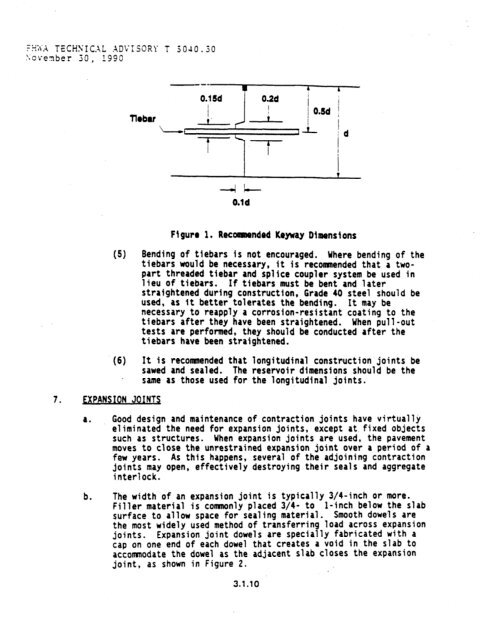chapter 3 rigid pavement - DOT On-Line Publications - Department ...
chapter 3 rigid pavement - DOT On-Line Publications - Department ...
chapter 3 rigid pavement - DOT On-Line Publications - Department ...
Create successful ePaper yourself
Turn your PDF publications into a flip-book with our unique Google optimized e-Paper software.
?%‘.4 TECHWIC.4L ADVISORY T 3040.30<br />
\iovernber 30, 1990<br />
(5)<br />
7. DPANSION JOINTS<br />
-4 L<br />
O.ld<br />
Figure 1. Recoarnended Keyway Dimensions<br />
Bending of tiebars is not encouraged. Where bending of the<br />
tiebars would be necessary, it is reconmnended that a two-<br />
part threaded tiebar and splice coupler system be used in<br />
lieu of tiebars. If tiebars must be bent and later<br />
straightened during construction, Grade 40 steel should be<br />
used, as it better tolerates the bending. It may be<br />
necessary to reapply a corrosion-resistant coating to the<br />
tiebars after they have been straightened. When pull-out<br />
tests are performed, they should be conducted after the<br />
tiebars have been straightened.<br />
(6) It is recommended that longitudinal construction joints be<br />
sawed and sealed. The reservoir dimensions should be the<br />
same as those used for the longitudinal joints.<br />
a. Good design and maintenance of contraction joints have virtually<br />
eliminated the need for expansion joints, except at. fixed objects<br />
such as structures. When expansion joints are used, the <strong>pavement</strong><br />
moves to close the unrestrained expansion joint over a period of a<br />
few years. As this happens, several of the adjoining contraction<br />
joints may open, effectively destroying their seals and aggregate<br />
interlock.<br />
b. The width of an expansion joint is typically 3/4-inch or more.<br />
filler material is commonly placed 3/4- to l-inch below the slab<br />
surface to allow space for sealing material. Smooth dowels are<br />
the most widely used method of transferring load across expansion<br />
joints. Expansion joint dowels are specially fabricated with a<br />
cap on one end of each dowel that creates a void in the slab to<br />
accommodate the dowel as the adjacent slab closes the expansion<br />
joint, as shown in Figure 2.<br />
3.1.10
















